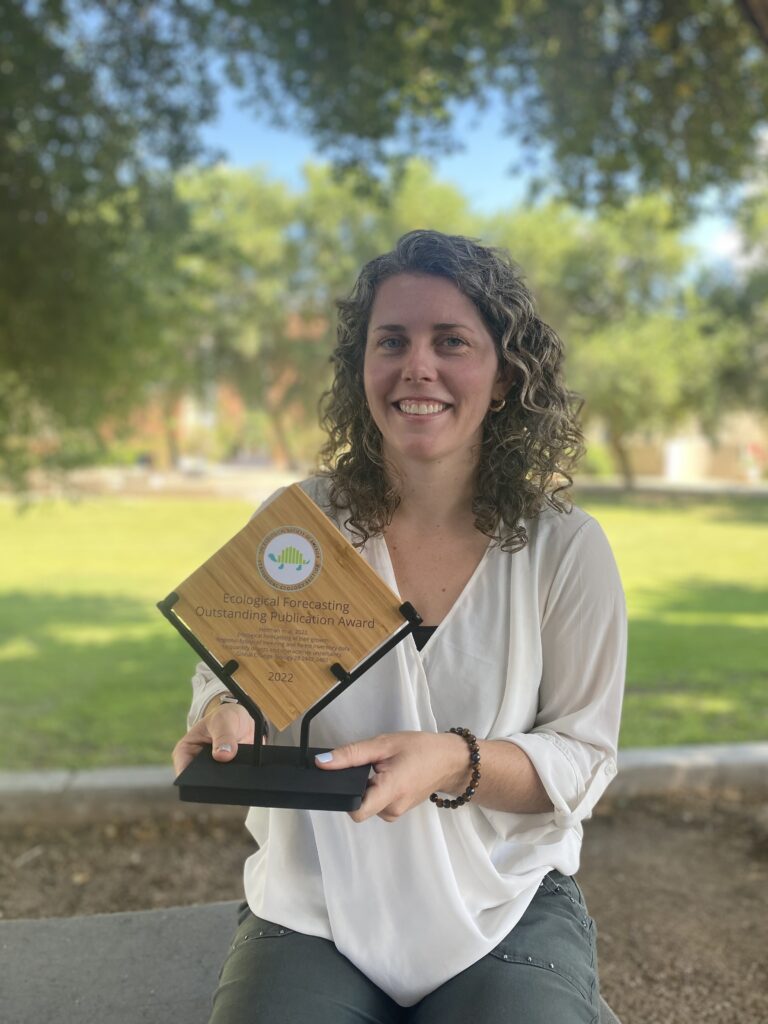September 18, 2024
Fullscreen ModeCategory Archives: Awards
EFI Newsletter Issue 43
Congratulations to Cerres Barros on the 2024 ESA Ecological Forecasting Award!
The ESA Statistical Ecology section presented the 2024 Ecological Forecasting Outstanding Publication Award to Cerres Barros and co-authors, Yong Luo, Alex Chubaty, Ian Eddy, Tatiane Micheletti, Céline Boisvenue, David Andison, Steven Cumming, & Eliot McIntire, for their 2023 Methods in Ecology and Evolution paper:

The award committee was strongly impressed by the way this paper clearly organized and presented cyberinfrastructure principles that are an increasingly important part of doing ecology well. This paper helps to translate software engineering concepts into clear take home messages that are accessible to ecologists (e.g., predictions depend on workflows, not just models) and draws attention to the need for Interdisciplinary teamwork in successful ecological forecasting. The committee was further impressed by this team’s commitment to developing tools that are accessible, reusable, and multi-purpose, and that address the challenges of operationalizing ecological forecasts.
In addition to an award plaque and prize ($200), this year’s recipient will also receive a £120 credit from Routledge books.
Nominate Papers for the 2025 Award
Individuals wishing to nominate papers published in the past 3 years for the 2025 award are encouraged to do so by the March 1, 2025 deadline. Additional information can be found at https://www.esa.org/stats/awards/ecological-forecasting-outstanding-publication-award/
Full List of Award Winners & Citations
2024 – Cerres Barros (University of British Columbia)
Barros, C., Luo, Y., Chubaty, A. M., Eddy, I. M. S., Micheletti, T., Boisvenue, C., Andison, D. W., Cumming, S. G., & McIntire, E. J. B. (2023). Empowering ecological modellers with a PERFICT workflow: Seamlessly linking data, parameterisation, prediction, validation and visualisation. Methods in Ecology and Evolution, 14, 173–188. https://doi.org/10.1111/2041-210X.14034
2023 – Jacob Zwart (USGS)
Zwart, J.A., Oliver, S.K., Watkins, W.D., Sadler, J.M., Appling, A.P., Corson-Dosch, H.R., Jia, X., Kumar, V., and Read, J.S. 2023. “Near-Term Forecasts of Stream Temperature Using Deep Learning and Data Assimilation in Support of Management Decisions.” JAWRA Journal of the American Water Resources Association 59 (2): 317–37. https://doi.org/10.1111/1752-1688.13093.
2022 – Kelly Heilman (University of Arizona)
Heilman, K.A., Dietze, M.C., Arizpe, A.A., Aragon, J., Gray, A., Shaw, J.D., Finley, A.O., Klesse, S., DeRose, R.J., & Evans, M.E.K. (2022). Ecological forecasting of tree growth: Regional fusion of tree-ring and forest inventory data to quantify drivers and characterize uncertainty. Global Change Biology 28(7):2442-2460 doi.org/10.1111/gcb.16038
2021 – Sarah Saunders (National Audubon Society)
Saunders, S.P., F.J. Cuthbert, and E.F. Zipkin. “Evaluating Population Viability and Efficacy of Conservation Management Using Integrated Population Models.” Journal of Applied Ecology 55, no. 3 (2018): 1380–92. https://doi.org/10.1111/1365-2664.13080.
2020 – Paige Howell (USGS)
Howell, P.E., B.R. Hossack, E. Muths, B.H. Sigafus, A. Chenevert‐Steffler, and R.B. Chandler. “A Statistical Forecasting Approach to Metapopulation Viability Analysis.” Ecological Applications 30, no. 2 (2020): e02038. https://doi.org/10.1002/eap.2038.
2019 – Maria Paniw (CREAF, Ecological and Forestry Applications Research Centre)
Paniw, M., N. Maag, G. Cozzi, T. Clutton-Brock, and A. Ozgul. “Life History Responses of Meerkats to Seasonal Changes in Extreme Environments.” Science 363, no. 6427 (February 8, 2019): 631–35. https://doi.org/10.1126/science.aau5905.
2018 – Quinn Thomas (Virginia Tech)
Thomas, R.Q., E.B. Brooks, A.L. Jersild, E.J. Ward, R.H. Wynne, T.J. Albaugh, H. Dinon-Aldridge, et al. “Leveraging 35 Years of Pinus Taeda Research in the Southeastern US to Constrain Forest Carbon Cycle Predictions: Regional Data Assimilation Using Ecosystem Experiments.” Biogeosciences 14, no. 14 (2017): 3525–47. https://doi.org/10.5194/bg-14-3525-2017.
EFI Newsletter Issue 42
EFI Futures Outstanding Student Presentation Award 2024 Results
The EFI2024 Conference provided the second opportunity for EFI to give out the EFI Futures Outstanding Student Presentation Award. This award is given to promote, recognize, and reward an outstanding student presenter and provides valuable feedback to student presenters on their research and presentation skills. Awards were given to students who gave both Posters and Oral Presentations. Poster or oral presentations were anonymously reviewed by three volunteer reviewers with no conflicts of interest with the presenters. In addition to being recognized for their outstanding work, award winners get to select any item from the EFI shop. We thank all the students who presented and the volunteers who reviewed the presentations!
Congratulations to this year’s Outstanding Presentation Award recipients!
- Gabrielle Koerich (University of Canterbury) won for her oral presentation, “Modelling bryophyte distributions in Antarctica: unveiling the influence of water availability, sampling bias, and spatially complex dynamics” and
- Nima Farchadi (San Diego State University) won for his poster “Integrating diverse data for robust species distribution models in a dynamic ocean.”
See Gabrielle and Nima’s presentation details below.

Modelling bryophyte distributions in Antarctica: unveiling the influence of water availability, sampling bias, and spatially complex dynamics
Gabrielle Koerich1 , Hao Ran Lai1 , Grant Duffy2 , Eva B. Nielsen1 , Jonathan D. Tonkin1
1University of Canterbury, Christchurch, New Zealand. 2University of Otago, Dunedin, New Zealand
Abstract: In Antarctica, observations of biodiversity are often incomplete and commonly restricted to presence-only data, as sampling in the continent is difficult. Thus, understanding and forecasting the range dynamics of key taxa, such as bryophytes, requires a modelling framework capable of dealing with such challenges. Here, we developed log-Gaussian Cox process models of bryophytes’ across the entire Antarctic continent to (1) assess whether broad-scale bryophytes distributions are driven by water availability, as widely hypothesized; (2) map and forecast their distributions and identify under sampled regions; and (3) determine if there’s a spatial dependency between “patches” of bryophytes, which may be related to their limited dispersal in Antarctica. Results show that the main driver of bryophytes distributions in Antarctica is indeed related to areas where water tends to accumulate (97.5% CI:-0.886;-0.797). Maximum temperature was the second most important predictor (97.5% CI: 0.511; 0.681), signalling the importance of elevated temperatures for bryophytes’ restricted metabolism in this extreme environment. The covariate related to human activity showed a high level of sampling bias, and by accounting for this covariate in predictions, we detected habitat suitability for bryophytes in two under-sampled mountain ranges. Finally, the inclusion of a Gaussian random field to account for spatial autocorrelation increased model performance (pseudo R2 and mapped mean estimated density), indicating a spatial dependency between the presence of mosses. Our study demonstrates that a spatially structured modelling framework can provide robust results and allow for valuable forecasts of biodiversity change in data-poor regions.
Integrating diverse data for robust species distribution models in a dynamic ocean
Nima Farchadi1 , Camrin Braun2 , Martin Arostegui2 , Rebecca Lewison1
1San Diego State University, San Diego, USA. 2Woods Hole Oceanographic Institution, Woods Hole, USA
Abstract: Species distribution models (SDMs) are an important tool for marine conservation and management. Despite the burgeoning use of SDMs, limited guidance is available on how to leverage distinct data types to build robust models. Here we assess whether an integrative model framework improves performance over traditional data pooling or ensemble approaches when synthesizing multiple data types. We trained traditional, correlative SDMs and integrative SDMs (iSDMs) with three distinct data types that represent the distribution of a heavily exploited pelagic fish, the blue shark (Prionace glauca), in the North Atlantic. Weevaluated data pooling and ensembling approaches in a correlative SDM framework and compared performance to a model-based data integration approach designed to explicitly account for data-specific biases while retaining the strengths of each dataset. We found that while each integration approach can result in robust models, there was variation in predictive accuracy among data types, with all models predicting fishery-dependent data more accurately than fishery-independent data. Differences in performance were primarily attributed to each model’s ability to explain the spatiotemporal dynamics of the training data, with iSDMs including spatiotemporal terms to have the most accurate and ecological realistic estimates. Our findings reveal trade-offs in the current techniques for integrating data in SDMs between accurately estimating species distributions, generating ecologically realistic predictions, and practical feasibility. With increasing access to growing and diverse data sources, comparing integration approaches can provide valuable guidance for practitioners navigating diverse data types in SDM development and will help users better understand model biases and estimate error.
EFI Newsletter Issue 36
Congratulations to Jacob Zwart on the 2023 ESA Ecological Forecasting Award!
The ESA Statistical Ecology section presented the 2023 Ecological Forecasting Outstanding Publication Award to Jacob Zwart and collaborators for their 2022 Journal of the American Water Resources Association paper:

The award committee was impressed by the novel methodological contributions of the paper, in fusing machine learning with traditional data assimilation approaches. The committee also values the authors’ ability to put this forecast into operations, to tie a novel forecasting approach to actionable real-world decisions, and the overall readability and approachability of what is otherwise a very technical paper.
Nominate Papers for the 2024 Award
Individuals wishing to nominate papers published in the past 3 years for the 2024 award are encouraged to do so by the March 1, 2024 deadline. Additional information can be found at https://www.esa.org/stats/awards/ecological-forecasting-outstanding-publication-award/
Full List of Award Winners & Citations
2023 – Jacob Zwart (USGS)
Zwart, J.A., Oliver, S.K., Watkins, W.D., Sadler, J.M., Appling, A.P., Corson-Dosch, H.R., Jia, X., Kumar, V., and Read, J.S. 2023. “Near-Term Forecasts of Stream Temperature Using Deep Learning and Data Assimilation in Support of Management Decisions.” JAWRA Journal of the American Water Resources Association 59 (2): 317–37. https://doi.org/10.1111/1752-1688.13093.
2022 – Kelly Heilman (University of Arizona)
Heilman, K.A., Dietze, M.C., Arizpe, A.A., Aragon, J., Gray, A., Shaw, J.D., Finley, A.O., Klesse, S., DeRose, R.J., & Evans, M.E.K. (2022). Ecological forecasting of tree growth: Regional fusion of tree-ring and forest inventory data to quantify drivers and characterize uncertainty. Global Change Biology 28(7):2442-2460 doi.org/10.1111/gcb.16038
2021 – Sarah Saunders (National Audubon Society)
Saunders, S.P., F.J. Cuthbert, and E.F. Zipkin. “Evaluating Population Viability and Efficacy of Conservation Management Using Integrated Population Models.” Journal of Applied Ecology 55, no. 3 (2018): 1380–92. https://doi.org/10.1111/1365-2664.13080.
2020 – Paige Howell (USGS)
Howell, P.E., B.R. Hossack, E. Muths, B.H. Sigafus, A. Chenevert‐Steffler, and R.B. Chandler. “A Statistical Forecasting Approach to Metapopulation Viability Analysis.” Ecological Applications 30, no. 2 (2020): e02038. https://doi.org/10.1002/eap.2038.
2019 – Maria Paniw (CREAF, Ecological and Forestry Applications Research Centre)
Paniw, M., N. Maag, G. Cozzi, T. Clutton-Brock, and A. Ozgul. “Life History Responses of Meerkats to Seasonal Changes in Extreme Environments.” Science 363, no. 6427 (February 8, 2019): 631–35. https://doi.org/10.1126/science.aau5905.
2018 – Quinn Thomas (Virginia Tech)
Thomas, R.Q., E.B. Brooks, A.L. Jersild, E.J. Ward, R.H. Wynne, T.J. Albaugh, H. Dinon-Aldridge, et al. “Leveraging 35 Years of Pinus Taeda Research in the Southeastern US to Constrain Forest Carbon Cycle Predictions: Regional Data Assimilation Using Ecosystem Experiments.” Biogeosciences 14, no. 14 (2017): 3525–47. https://doi.org/10.5194/bg-14-3525-2017.
EFI Newsletter Issue 27
Congratulations to Kelly Heilman on the 2022 ESA Ecological Forecasting Award!
The ESA Statistical Ecology section is proud to present the 2022 Ecological Forecasting Outstanding Publication Award to Kelly Heilman and collaborators for their 2022 Global Change Biology Paper:

The award committee felt that the paper illustrates the strength of combining multiple data constraints across regional scales to improve predictions of forest growth for a climatically-vulnerable ecoregion, the American Southwest, parsing out the complex interactions among climate, stand, and individual-scale effects. Furthermore, the paper provides a detailed accounting of how different uncertainties impact growth projections across a range of time scales and climate projections, finding that tree growth and tree size were sensitive to very different uncertainties (year-to-year growth was dominated by driver uncertainty and process error, while tree size was more sensitive to initial conditions and plot random effects).
Individuals wishing to nominate papers published in the past 3 years for the 2023 award are encouraged to do so by the March 1, 2023 deadline. Additional information can be found at https://www.esa.org/stats/awards/ecological-forecasting-outstanding-publication-award/
Full List of Award Winners & Citations
2022 – Kelly Heilman (University of Arizona)
Heilman, K. A., Dietze, M. C., Arizpe, A. A., Aragon, J., Gray, A., Shaw, J. D., Finley, A. O., Klesse, S., DeRose, R. J., & Evans, M. E. K. (2022). Ecological forecasting of tree growth: Regional fusion of tree-ring and forest inventory data to quantify drivers and characterize uncertainty. Global Change Biology 28(7):2442-2460 doi.org/10.1111/gcb.16038
2021 – Sarah Saunders (National Audubon Society)
Saunders, S.P., F.J. Cuthbert, and E.F. Zipkin. “Evaluating Population Viability and Efficacy of Conservation Management Using Integrated Population Models.” Journal of Applied Ecology 55, no. 3 (2018): 1380–92. https://doi.org/10.1111/1365-2664.13080.
2020 – Paige Howell (USGS)
Howell, P.E., B.R. Hossack, E. Muths, B.H. Sigafus, A. Chenevert‐Steffler, and R.B. Chandler. “A Statistical Forecasting Approach to Metapopulation Viability Analysis.” Ecological Applications 30, no. 2 (2020): e02038. https://doi.org/10.1002/eap.2038.
2019 – Maria Paniw (CREAF, Ecological and Forestry Applications Research Centre)
Paniw, M., N. Maag, G. Cozzi, T. Clutton-Brock, and A. Ozgul. “Life History Responses of Meerkats to Seasonal Changes in Extreme Environments.” Science 363, no. 6427 (February 8, 2019): 631–35. https://doi.org/10.1126/science.aau5905.
2018 – Quinn Thomas (Virginia Tech)
Thomas, R.Q., E.B. Brooks, A.L. Jersild, E.J. Ward, R.H. Wynne, T.J. Albaugh, H. Dinon-Aldridge, et al. “Leveraging 35 Years of Pinus Taeda Research in the Southeastern US to Constrain Forest Carbon Cycle Predictions: Regional Data Assimilation Using Ecosystem Experiments.” Biogeosciences 14, no. 14 (2017): 3525–47. https://doi.org/10.5194/bg-14-3525-2017.
